According to the WOMMA Wombat2 2006 study roughly 88% of internet users
“locate websites” using search engines. This is a rather
obvious fact and we do our best with our Search Engine Optimization
(SEO) and Search Engine Marketing (SEM) efforts to maximize our
exposure via search engines (Google, Yahoo, MSN, Ask etc).
But as might be obvious not all search efforts are created equal.
Specifically in the context of key words and key phrases for your
business there are those that bring in gobs and gobs of traffic and
then there is the, now famous, delightful long tail.
This post is a bit long but, I think, it contains non-obvious challenging concepts from which anyone could benefit. You’ll dive deep into search analysis with these three parts:
- Compute: How thick is your “head”? How long is your “tail”?
- Learn: Definitions of Brand & Category phrases & why they matter.
- Execute: A new killer Search Marketing strategy.
Each part can be studied independently and I am confident
you’ll find it beneficial. But my hidden agenda is to share with
you a radical way to rethink your search marketing program. Please read
the whole thing when you have time, I promise you’ll either end
up making lots of money or saving lots of money!
Understanding the Long Tail:
There is some confusion about what the “long tail” really refers to. Put simply it states: lots
of key phrases individually account for little traffic by themselves
but collectively all those key phrases often could account for a huge
amount of traffic. The long tail phenomenon is not unique to
search keywords, it has often been used to describe the success of
amazon.com (powered by the efficiencies that the internet enables).
The below image illustrates the phenomenon. In the x-axis are individual key phrases (Note: Did
you know that at some point last year the average number of keywords
used in a search in Google reached three? If your business is still
thinking in terms of one keyword you will miss a lot of traffic, the
name of the game is key phrases.) On y-axis are the number of visits that resulted from each key phrase (you can also use Visitors if you want).
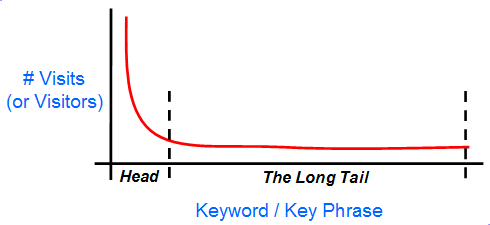
If you do this plot for your website you’ll notice that just a
few key phrases (ok, or key words) will account for most of your
visits. That’s your “Head”. Then
there will be lots of key phrases that will each contribute little
traffic, but there are lots of them. Meet your “Long Tail”.
Compute: How thick is your “head”? How long is your “tail”?
Go into the search report for your tool and look at the report that
shows all the keywords for the last, say, six months (if you are a
seasonal business pick the months that span your peak season).

It should look something like the above (mine above is from indexTools).
Dump the data into excel, just search key phrases by Visits would
do. Do a simple graph that has key phrases on x-axis and Visits on the
y-axis. This is what you’ll get (I had to cut off the tail in
this picture because it was really really long!):
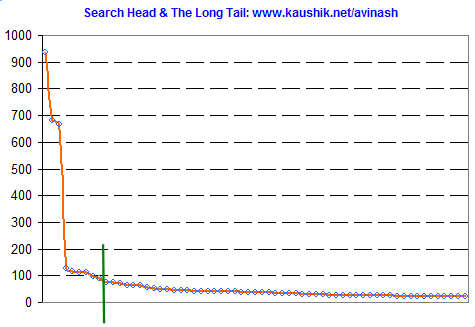
While your business might be different there is a high likelihood that your graph will look like the one above.
At approximately the tenth key phrase draw the green line,
that’s your head. If you are in a unique and diversified business
your head might be much be much thinner.
From my experience usually between five to fifteen key phrases
form the head, or imagined another way your head, again from my
experience (YMMV), approximately 55% to 75% of your traffic might be
coming from your head keywords (scary!!).
What insights will you find?
- First you have something pretty to look at, even with the ugliness of Excel. 🙂
All joking aside visualizing your search engine traffic in this manner can give you a whole new perspective of the game. This can be so insightful that I think this graph should be standard in all web analytics tools. - You’ll be humbled to find that while you have a world
dominating search strategy of 500,000 key phrases that just ten or so
result in almost all the traffic. - You’ll learn what are the key phrases for which you bear the
greatest exposure, someone else comes in a bids huge amounts for those
then you’ll lose lots. - It is likely that you’ll find that your Head portion is
dominated by Brand key phrases and your Tail is dominated by Category
key phrases.
This will in turn start critical discussions for your
search team / Agency about the most effective SEO and SEM (Pay Per
Click – PPC) strategy for your company.
Actions you might take:
- Undertake a critical analysis of your head and tail key
phrases. Are 10 key phrases enough? Should three be more? Is your
head only five keywords? What are the surprises in your long tail? Are
all your main key phrases stuffed there? What are the keywords that
people use to find you in your long tail that are surprising? - Work with you key decision makers to document exactly what your Search strategy should be.
- Partner with your Search Agency (or internal search team) to
evaluate if you giving the right “love and attention” to
your head and tail, what changes need to be made to your current
strategy?

Learn: Definitions of Brand & Category phrases & why they matter.
Definitions:
A brand key phrase (/key term / keyword) is typically defined as one
that is connected to your “company existence”. So brand key
phrases are your company name and names of your products and services,
they are your trademark etc.
Category key phrases are typically those that are not directly
connected with you and are more generic words and phrases that are
typically connected to your industry / ecosystem.
Some examples might help understand these definitions. From
the second figure on this post (the screenshot from indexTools):
Brand Key Phrases: occams razor, avinash kaushik, avinash, occams razor blog, 90/10 rule, 90 10 rule, kaushik.
Category Key Phrases: competitive intelligence, path analysis, how to measure success.
Some brand terms are obvious, name of the blog and my name. Other
are not quite obvious, 90/10 is also considered a brand term because I
had authored the 10/90 rule for magnificent web analytics success.
You’ll notice that category terms are specific to our industry but not specific to me/this blog.
Another example is that while Tide, Dawn, Bounty, Duracell and
Oral-B are brand terms for P&G, clean clothes, sparkling dishes,
kitchen supplies, portable power and whiter teeth are all category
terms.
Why should you care?
When it comes to search key phrases this is the typical distribution you’ll see in your head and tail analysis:
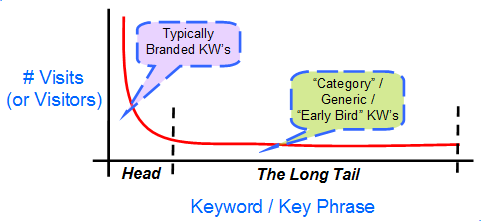
Most of your visitors will find you using your Brand terms. That
makes sense because more people who type in key phrases associated
with you will find your web pages higher in the search results and
hence will most likely end up on your website.
Your long tail will be full of Category key terms simply because
these are people who are searching using generic key phrases. For these
phrases others will show up in the search results and you’ll have
to work much harder to show up on page one.
Another important distinction is that visitors who search using your
Brand key phrases typically know who you are in some way, that should
be obvious because they are using key words most associated with you.
Visitors who use Category key phrases are usually not your customers,
they are people early in the buying cycle, they are in a research mode,
they are looking for options. Some Marketers refer to these types of
Visitors as Prospects.
Bottom-Line: You should worship at the alter of
the Category gods if you want to grow your business. You
want to show up higher in search results when Searchers are still
considering their options and have not made up their minds, it is a
opportunity to capture new customers by exposing your brand early on.
Now let’s tie this all together……
Execute: A new killer Search Marketing strategy.
Many companies have a sub optimal SEO and SEM (PPC) execution
strategy. When someone comes to a marketer with a pot of money to do
search engine marketing they immediately collect the key words and key
phrases that are most closely associated with the company and go bid on
them. As a result often almost entire SEM budgets are expended on
trying to show up # 1 in sponsored listing (to avoid the
“cataclysmic event” of not showing up #1 – note the hint of
sarcasm).
Go back to Excel and your search key phrase analysis and your head
– tail graphs (it gets a bit more advanced from here on).
First split out the percentage of Visits in your head key phrases
that result from SEM (PPC) vs Organic (SEO). Now do the same for your
Tail key phrases.
Second identify the amount of budget that you are spending on your head and tail key phrases.
The result might look like this:
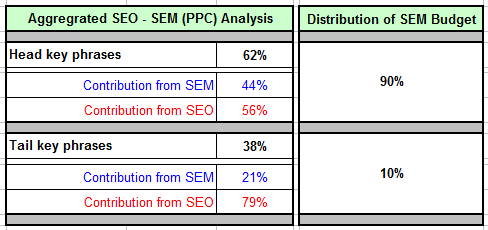
What insights will you find?
There is some amazingly powerful stuff here, let this table slosh around in your brain for a few minutes. 🙂
Most of your SEM money is being spent on the head key phrases.
Remember that is just the top ten or fifteen keywords. There is also no
solace in realizing that those key phrases are almost all your Brand
key phrases which will typically not bring Visitors who are Prospects
to your site (Prospects who will help you grow your business).
You might also notice that while you spend such a small part of your
budget on your long tail key words (and they are in all likelihood
Category key phrases) that you are able to get a huge bang for
the buck.
Bottom-Line: If you had a effect SEO & SEM
strategy should you have to pay to get traffic that you rightly deserve
(your brand traffic)?
Actions you might take:
Optimize your SEO and SEM strategies.
If you have a effective search engine optimization strategy then you
should show up with a high rank when people search for brand key
phrases. Piling on and paying huge bid amounts through your SEM
programs just to make up for the fact that your SEO strategy is
ineffective or not working is sub optimal (and expensive).
It also means that all your SEM spend is focussed on getting people
who know you. How will you grow (find prospects) your business if that
is the case?
Killer Search Marketing strategy recommendation:
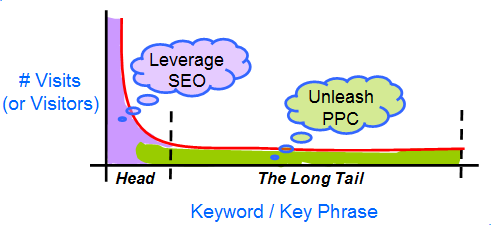
(Ok ok I know that the graphic above illustrates that I am not a good artist! : )).
# 1 Focus your SEM budgets deliberately to leverage the Long Tail (/Category key terms).
It is very hard to show up high when people search using
Category (generic) key phrases, there are lots of
“competitors”.
The most powerful use of your search marketing budget is to show up
high in sponsored results (SEM / PPC) for Category key phrases.
You’ll capture prospects and introduce yourself to them early in
the consideration / buying cycle.
Another feature of Category terms is that they cost less, because
they are usually generic and focus on niches and you won’t find
lots of competition there, so you can use the same budget to bid on
more key phrases (this is why ebay shows up on every term under the
sun).
# 2 Focus all your SEO efforts on SEO’ing the heck out
of your website / web pages for your Brand key terms (those that are in
your Head).
This simplifies your SEO problem greatly by having you focus on,
say, twenty key phrases. How hard can that be? It will be also be much
easier to truly optimize your site with such hyper focus (vs. trying to
globally optimize your site by SEO efforts that contain forty seven
thousand keywords and key phrases).
If you do this well you’ll show up high when Visitors search
using your brand key terms. It also means that you are not paying too
much for people who already know you (you’ll reach them through
your effort #1 above.)
Of course this will not happen over time but you can easily imagine
how you can slowly ramp up your SEO efforts and start getting traffic
on Brand terms and at the same time start bidding on your Category key
terms.
This is not globally adaptable to 100% of the businesses
on the web, but hopefully it challenges 100% of you to think different
about your search strategy.
In Conclusion: The Summary:
Understanding how your head and the long tail stacks up can be a
powerful source of insights. If you adapt your SEO and SEM strategy to
effectively leverage your strengths (your brand) then you’ll be
able to use your limited marketing funds to focus on attracting new
customers to your franchise and do so at a beautifully optimal price
point.
